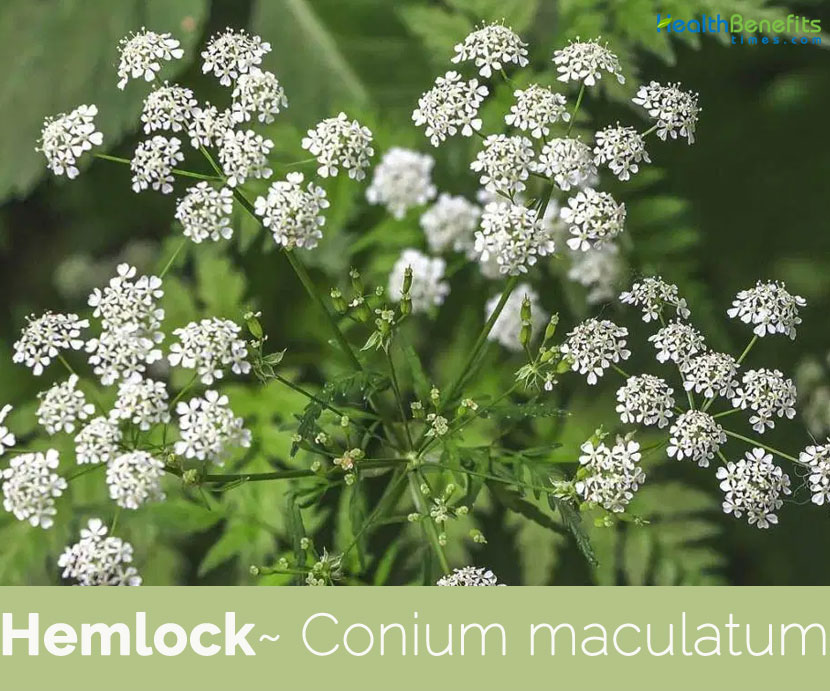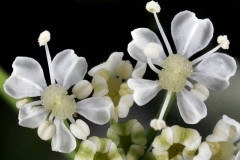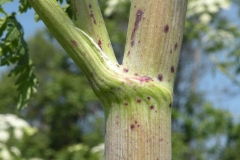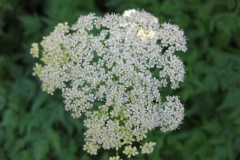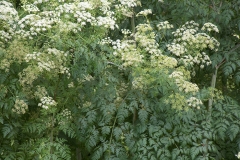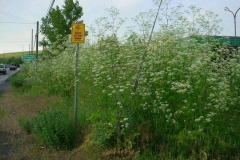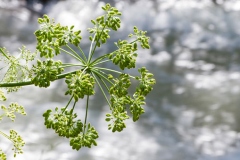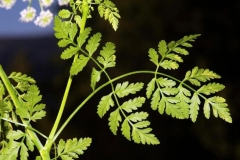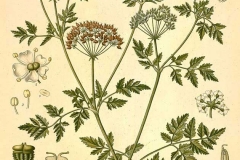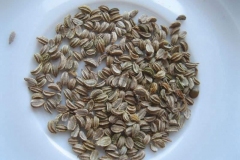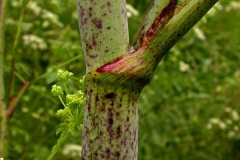Hemlock Facts
| Hemlock Quick Facts | |
|---|---|
| Name: | Hemlock |
| Scientific Name: | Conium maculatum |
| Origin | Northern Europe, western Asia and North Africa |
| Colors | Green when young turning to grayish brown |
| Shapes | Woody schizocarp, broadly ovoid, slightly compressed laterally, 2–4 mm long, 2–3 mm wide and 1.5–2 mm thick |
| Taste | Bitter |
| Health benefits | Beneficial for malignant tumors, epilepsy, whooping cough, rabies, anal fissure, hemorrhoids, dizziness, insomnia, exhaustion, arteriosclerosis, prostate problems |
| Name | Hemlock |
|---|---|
| Scientific Name | Conium maculatum |
| Native | Europe (i.e. Denmark, Finland, Ireland, Norway, Sweden, UK, Austria, Belgium, Czechoslovakia, Germany, Hungary, the Netherlands, Poland, Switzerland, Belarus, Estonia, Latvia, Lithuania, Moldova, Ukraine, Albania, Bulgaria, Greece, Italy, Romania, Yugoslavia, France, Portugal and Spain), northern Africa (i.e. Algeria, Morocco, Tunisia and Ethiopia), western Asia, China and the Indian Sub-continent (i.e. northern India and northern Pakistan) |
| Common Names | Common hemlock, deadly hemlock, California fern, carrot fern, fool’s parsley, hemlock, poison fool’s parsley, poison hemlock, poison parsley, poison root, snake weed, spotted hemlock, spotted parsley, wild carrot, wild parsnip, winter fern, wode whistle, Canada pitch tree, hemlock gum tree, hemlock pitch tree, hemlock tree, eastern hemlock, weeping spruce, pine tops, tanner’s bark, hemlock bark, hemlock leaves, hemlock spruce, water hemlock, spotted cowbane, herb bennet, spotted corobane, musquash root |
| Name in Other Languages | Afrikaans: Hemlock Albanian: Kukutë, Kakuda, kukuta e njollosur Amharic: Hīmoki (ሂሞክ) Arabic: Alshuwakran (الشوكران), shuakran ‘abqae (شوكران أبقع) Armenian: Hemlok (հեմլոկ), ginazokh btsavor (գինազոխ բծավոր) Azerbaijani: Hemlock, Xallı badyan Bengali: Biṣalatābiśēṣa (বিষলতাবিশেষ), Kaniẏāma myākulēṭāma (কনিয়াম ম্যাকুলেটাম) Basque: Astaperrexil handi Brazilian: Cicuta, funcho-selvagem Bulgarian: Bučiniš (бучиниш), petnist bučiniš (петнист бучиниш) Burmese: Hellhell (ဟဲဟဲ) Catalan: Cicuta, Fonollassa, Juliverd de galàpet, Julivertassa, ceguda, cicuta boscle, cicuta major, fonoll de bou, fonollasa, sacuta Chinese: Tiě shān (铁杉), du shen, , dú cān shǔ (毒参属) Croatian: Kukuta, pjegava velika kukuta Czech: Bolehlav , Bolehlav plamatý, Bolehlav škvrnitý, Danish: Hemlock, Eng-Brandbæger, Skarntyde, Smalfliget Brandbæger, Giftkjeks Dutch: Hemlock, Gevlekte scheerling English: hemlock, Poison Hemlock, Carrot-fern, Deadly hemlock, Fool’s-parsley, Poison parsley, Spotted-hemlock, Spotted-parsley, Common poison-hemlock, Spotted parsley, Cigue maculee, cigue tachetee, devil’s bread, devil’s porridge, poison hemlock, poison parsley, spotted corobane, poison hemlock, Estonian: Täpiline surmaputk Esperanto: Branĉeto, Makula konio Erzya: Teshksev guyen’pochko (Тешксэв гуеньпочко) Estonian: Hemlock, Täpiline surmaputk Filipino: Hemlock, Jaakonvillakko, Liuskavillakko, Myrkkykatko Finnish: Katko, Myrkkykatko French: Ciguë, Grande ciguë, Cigüe maculée, Ciguë d’Europe, Ciguë tachetée, Ciguë tachée, ciguë à tige maculée Galician: Cicuta Georgian: Hemlok’I (ჰემლოკი) German: Schierling, Gefleckter Schierling, Flecken-Schierling, Fleckenschierling, Tollkraut, Wüterich, Ziegendill, Bangenkraut, Blutpeterlein, Blutschierling, echter Schierling, Erdschierling, Europa-Fleckenschierling, gefleckter Schierling, Katzenpeterlein, Krottenpeterling, Mäuseschierling, stinkender Schierling, Teufelspeterlein, Tollkerbel, Tollkörfel, Vogeltod, Würgling, Greek: Kóneio (κώνειο), Kóneio to stiktón (Κώνειον το στικτόν) Guatemala: Perejil de chucho, perejil de monte Gujarati: Hēmalōka (હેમલોક) Hausa: Basur Hebrew: Hemlock, rosh akod, רוֹשׁ עָקֹד Hindi: Hemalok (हेमलोक) Hungarian: Bürök, foltos bürök Icelandic: Þöll, Òðjurt Indonesian: Hemlock Ido: Cikuto Irish: Hemlock, Moing mhear Italian: Cicuta, Cicuta maggiore Japanese: Hemurokku (ヘムロック), , dokuninjin (ドクニンジン) Javanese: Hemlock Kannada: Hemlāk (ಹೆಮ್ಲಾಕ್) Kazakh: hemlok (гемлок), Wbaldırğan (Убалдырған), ۋبالدىرعان Kirghiz: Sasık baltırkan (Сасык балтыркан) Korean: Hemlog (헴록), na do dok mi na ri (나도독미나리) Ku Arab: گیاژەهرک Kurdish: Hemlock, Giyajehrk Lao: Hemlock-ˈhemˌläk Latin: Minorem scissionibus Latvian: Hemlock, plankumainais suņstobrs Lithuanian: Hemlock, Dėmėtoji mauda Macedonian: Khemok (хемок) Malagasy: Zava-mahafaty Malayalam: Henlēākk (ഹെംലോക്ക്), hemlēāk plānṟ (ഹെമ്ലോക് പ്ലാന്റ്) Maltese: Hanut Marathi: Hemalok (हेमलॉक) Mongolian: Hemlock-ˈhemˌläk Nepali: Hemalok (हेमलोक) Netherlands: Gevlekte scheerling Norwegian: Hemlock, Landøyda, Smalsvineblom, Giftkjeks, Skarntyde, gevlekte scheerling Occitan: Cigudo, Jolverdassa Oriya: ହେମଲକ୍ Ossetian: Takwındela (Такъуындела) Pashto: هیملاک Persian: هملو, شوکران زهرآلود Picard: Chighu Polish: Cykuta, szczwół plamisty Portuguese: Cicuta, Cicuta-da-europa, Funcho-selvagem, Salsa-brava, Ansarinha-malhada, Cegude, abioto, ansarina-malhada, bálsamo-de-meca, cegude, cicuta-de-atenas, cicuta-maior, cicuta-oficinal, cicuta-ordinária, cicuta-terrestre, cicuta-verdadeira, legude, funcho-salvagem Punjabi: Hēmalauka (ਹੇਮਲੌਕ) Quechua: Jama-jama Romanian: Cucută Russian: Tsuga (тсуга), Boligolov pyatnistyy (Болиголов пятнистый), boligolov krapchatyy (болиголов крапчатый), boligolov pyatnistyy (болиголов пятнистый), omeg pyatnistyy (омег пятнистый) Scottish Gaelic: Minmhear, Moing mhear, Muing mhara, ith-teodha Serbian: Hemlock (хемлоцк), Kukuta (Кукута), velika kukuta (велика кукута), pegava kukuta (пегава кукута) Sicilian: Cicuta Sindhi: بدمعاش Sinhala: Hemlok (හෙම්ලොක්) Slovak: Bolehlav škvrnitý Slovenian: Smarnica, pikasti mišjak Spanish: Cicuta, Encaje cimarrón, Panalillo, Zanahoria Silvestre, Pikasti mišjak, encaje cimarrón, perejil de chucho, perejil de monte, zanahoria Silvestre, cañahierra, cicuta mayor, embude, perejil de las brujas, perejilón, prixel de las bruxas, perejillón, sarrac Sudanese: Hemlock Swedish: Odört, Flikstånds, Hampstånds, Höstrudbeckia, Stånds, Myrkkykatko Tajik: Hemlock-ˈhemˌläk Tamil: Hēmlāk (ஹேம்லாக்) Telugu: Kōniyaṁ (కోనియం) Thai: Phụ̄ch thī̀ mī phis̄ʹ chnid h̄nụ̀ng (พืชที่มีพิษชนิดหนึ่ง) Turkish: Baldıranotu, Baldiran Ukranian: Badyllya (бадилля), Boligolov plyamistiy (Болиголов плямистий) Urdu: ہیملاک Uzbek: Qon tomir, Zangpoya Vepsian: Omeghein Vietnamese: Bế tắc Welsh: Cegid, Cegiden Zulu: Hemlock |
| Plant Growth Habit | Highly poisonous, upright and short-lived biennial herbaceous flowering plant |
| Growing Climates | Grassland, forest margins, riparian habitats, freshwater wetlands, waste ground, disturbed sites, field margins and fallows, riverbeds, palustral, forest margins, stockyards, along roadsides, riverbanks, hedgerows, roadsides, banks of streams and rivers, pastures, and wood lots |
| Soil | Plant is often found in poorly drained soil, particularly near streams, ditches and other watery surfaces |
| Plant Size | 1.5–2.5 m (5–8 ft.) tall |
| Root | Long taproot is forked, white or pale yellow and 1-2 cm in diameter |
| Stem | 0.5-3 m high, stout, erect, branched, glabrous, hollow except at the nodes, have longitudinal lines and purple markings and produce an offensive odor when damaged. |
| Branches | Smooth, pale green branches usually are covered with purple spots |
| Leaf | Fern-like, opposite, glabrous, with a strong mouse-urine smell when crushed. Whole upper leaves are sessile. The lower leaf blades are 15-30 cm long and are petioled. All leaves have prominent veins on the undersides |
| Flowering season | June to September |
| Flower | Flowers are small with 5 white petals, numerous in compound flat-topped umbels at the ends of stems, produced from April to early July. |
| Fruit Shape & Size | Woody schizocarp, broadly ovoid, slightly compressed laterally, 2–4 mm long, 2–3 mm wide and 1.5–2 mm thick |
| Fruit Color | Green when young turning to grayish brown as they matures |
| Seed | Seeds are 2-2.5 cm long, grey or brown, short-lived (probably not more than 6 years), broadly ovoid, flattened laterally, glabrous, obtuse |
| Propagation | By Seed |
| Flavor/Aroma | Foetid, mousy odor when crushed |
| Taste | Bitter |
| Plant Parts Used | Root, Leaves, Flowering Stems, fruits, seeds |
| Culinary Uses |
|
Common hemlock, deadly hemlock, California fern, carrot fern, fool’s parsley, hemlock, poison fool’s parsley, poison hemlock, poison parsley, poison root, snake weed, spotted hemlock, spotted parsley, wild carrot, wild parsnip, winter fern, wode whistle, Canada pitch tree, hemlock gum tree, hemlock pitch tree, hemlock tree, eastern hemlock, weeping spruce, pine tops, tanner’s bark, hemlock bark, hemlock leaves, hemlock spruce, water hemlock, spotted cowbane, herb bennet, spotted corobane and musquash root are some of the popular common names of the plant. The generic name Conium is derived from the Greek word koneion or konas, meaning to whirl about, because the consumption of the plant causes ataxia, tremor and convulsions. The specific epithet maculatum is from the Latin and means “spotted,” “blotched,” or “bearing spots,” referring to the purplish mottling of the stems. According to legend, the purplish mottling represents the brand of Cain, put there after he had committed murder.
Plant Description
Conium maculatum is a highly poisonous, upright and short-lived biennial herbaceous flowering plant that normally grows about 1.5–2.5 m (5–8 ft.) tall. It is less readily confused with harmless cow parsley, with very pale, weaker stems and tiny red-and-green leaves next to many of its flower stems which colonizes bright areas. The plant is found growing in grassland, forest margins, riparian habitats, freshwater wetlands, waste ground, disturbed sites, field margins and fallows, riverbeds, palustral, forest margins, stockyards, along roadsides, riverbanks, hedgerows, roadsides, banks of streams and rivers, pastures, and wood lots. The plant is often found in poorly drained soil, mainly near streams, ditches and other watery surfaces. The plant has long taproot that is forked, white or pale yellow and 1-2 cm in diameter.
Stem
Stem is flattened during the rosette stage and elongates during the second year to form an upright flower stalk that is 2 to 8 feet tall. It is erect, smooth, slightly ridged, stout below, much branched above and hollow, and is bright green. It is distinctively mottled with small irregular purple spots.
Leaves
The alternately arranged leaves are borne on long hollow leaf stalks (i.e. petioles) that tend to sheath the stem at their bases. They are deeply divided with toothed (i.e. serrate) segments, and are ferny in appearance. These leaves are up to 50 cm long and 40 cm wide, but more commonly 12-25 cm long and are hairless (i.e. glabrous). Leaves attach to stems by way of leaf stalks (petioles) marked with purplish spots or blotches. Petioles broaden at their base and encircle the stem at each node. Upper leaf surfaces are dark green in color, while their undersides are a paler green or greyish-green. The stems and leaves give off a strong odor when crushed or damaged.
Flowers
The white flowers are borne in large numbers in dense flat-topped clusters at the tips of the branches (i.e. in terminal compound umbels). Individual flowers are small about 2-4 mm across, have five incurved petals and five stamens, and are borne on stalks (i.e. pedicels) up to 5 cm long. Many of these stalks radiate from the same point and form a small cluster of flowers (i.e. an umbel), with several (6-20) of these smaller clusters (often called rays) being grouped together into a much larger cluster (i.e. a compound umbel) that is subtended by several small leafy bracts (about 5 mm long). The petals of the small flowers are white with an inflexed point. The stamens of the flowers are longer than the petals and have white anthers. The inflorescence is produced mainly from June to September.
Fruits
Fruit a woody schizocarp, broadly ovoid, slightly compressed laterally, 2–4 mm long, 2–3 mm wide and 1.5–2 mm thick, with reflexed style remnants at apex of stylopodium and sometimes a pedicel remnant at base. Fruits are initially green turning to greyish-brown in color as it matures. It actually consists of two one-seeded structures (i.e. mericarps) that readily split apart when the fruit is fully mature. Each of these seeds are 2-4 mm long, pale-brown, hairless but has five noticeable yellowish-colored ribs.
Traditional uses and benefits of Hemlock
- It is a narcotic plant that sedates and relieves pain.
- The whole plant is analgesic, antispasmodic, emetic, galactofuge and sedative.
- It is a traditional folk treatment for cancer and was formerly widely used internally in very small doses to treat a variety of complaints including tumors, epilepsy, whooping cough, rabies and as an antidote to strychnine poisoning.
- It is still used externally, usually in ointments and oils, in the treatment of mastitis, malignant tumors (especially breast cancer) anal fissure and hemorrhoids.
- Leaves and stems should be harvested when the first fruits are forming, since they are then at their most active medicinally.
- Fruits are gathered either when fully ripe, or before they turn from green to yellow, and are then dried.
- Homeopathic remedy is prepared from a tincture of the fresh plant, harvested when in flower.
- It is used for treating complaints such as dizziness, coughs, insomnia, exhaustion, arteriosclerosis and prostate problems.
- It cures brain disorders like Anxiety, Epilepsy, Mania, Headache, Insomnia, Vertigo and Rabies.
- It treats stress related neurological disorders. These Stress problems may cause a feeling of numbness and weakness in the Hips and the Legs.
- It eases fatigue and energizes the body.
- It is widely used in curing Arteriosclerosis.
- It is beneficial in treating tissue inflammation and formation of cancerous lumps in the breast. It is a favorable treatment for swollen Breasts.
- Hemlock is a good herbal treatment for Cyst. It counters the tumor growth in ovary, uterus and testicles.
- It is beneficial in combating prostate problems namely, Prostate Tumor and Prostate enlargement.
- It relieves from muscular cramps and spasm.
- It eases painful Menses. It regulates menopause cycle, relieves from uneasiness and prevents formation of red colored Pimples on the body.
- It heals anal fissure.
- Hemlock curbs sexual disorders like premature ejaculation and sexual dysfunction.
- Its ointment and oil is helpful in treating Piles.
- It is effective in treating urinary disorders like Irregular Urine flow and pain during Urination.
- It acts as an antidote for Strychnine Poisoning.
- Twigs with many needles used in tea to treat kidney ailments.
- Steam from tea used to treat rheumatism, colds, and coughs.
- Bark is used in tea to treat colds, fevers, diarrhea, coughs, and scurvy.
- Bark poultice used for treating bleeding wounds.
- It was used as medicine (to treat muscle spasms and cause sedation as well as being applied to tumors).
- It was used externally to treat herpes, erysipelas (a form of superficial cellulites) and breast tumors.
Other Facts
- The poisonous nature of the plant varies significantly, with many people believing that the plant is less toxic when grown in cooler climates.
- Bark may also be useful for tanning leather.
- It is a persistent plant that can produce more than 1000 seeds in a season.
- The poisonous juice of this plant was used in ancient Greece as a means of executing criminals and other state prisoners including Socrates.
- This weed hosts many common diseases of alfalfa, celery, and carrot.
Precautions
- Toxins are especially concentrated in the seed.
- The toxins paralyse the respiratory nerves, causing death by suffocation.
- Children have been known to die after using the hollow stems as blowpipes.
- It may cause Paralysis and even Death.
- Consumption of Poison Hemlock can cause respiratory failure in less than 3 hours.
- Plant contains coniine, an extremely toxic substance that can also cause congenital defects.
References:
http://www.hear.org/pier/species/conium_maculatum.htm
https://npgsweb.ars-grin.gov/gringlobal/taxon/taxonomydetail?id=11262
https://pfaf.org/user/Plant.aspx?LatinName=Conium+maculatum
https://www.cabi.org/isc/datasheet/14820
http://www.floracatalana.net/conium-maculatum-l-
https://plants.usda.gov/core/profile?symbol=COMA2
https://www.itis.gov/servlet/SingleRpt/SingleRpt?search_topic=TSN&search_value=29473#null
https://www.invasiveplantatlas.org/subject.html?sub=4365
https://www.eddmaps.org/midwest/species/subject.cfm?sub=4365
https://en.wikipedia.org/wiki/Conium_maculatum
http://tn-grin.nat.tn/gringlobal/taxonomydetail.aspx?id=11262
http://www.theplantlist.org/tpl1.1/record/kew-2734165
https://keyserver.lucidcentral.org/weeds/data/media/Html/conium_maculatum.htm
https://gd.eppo.int/taxon/COIMA


